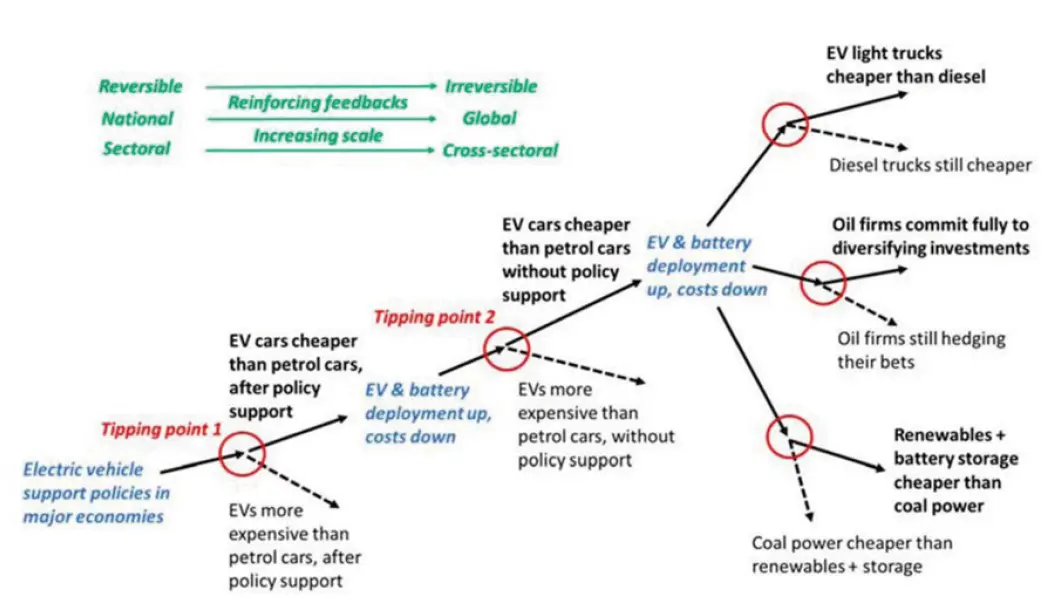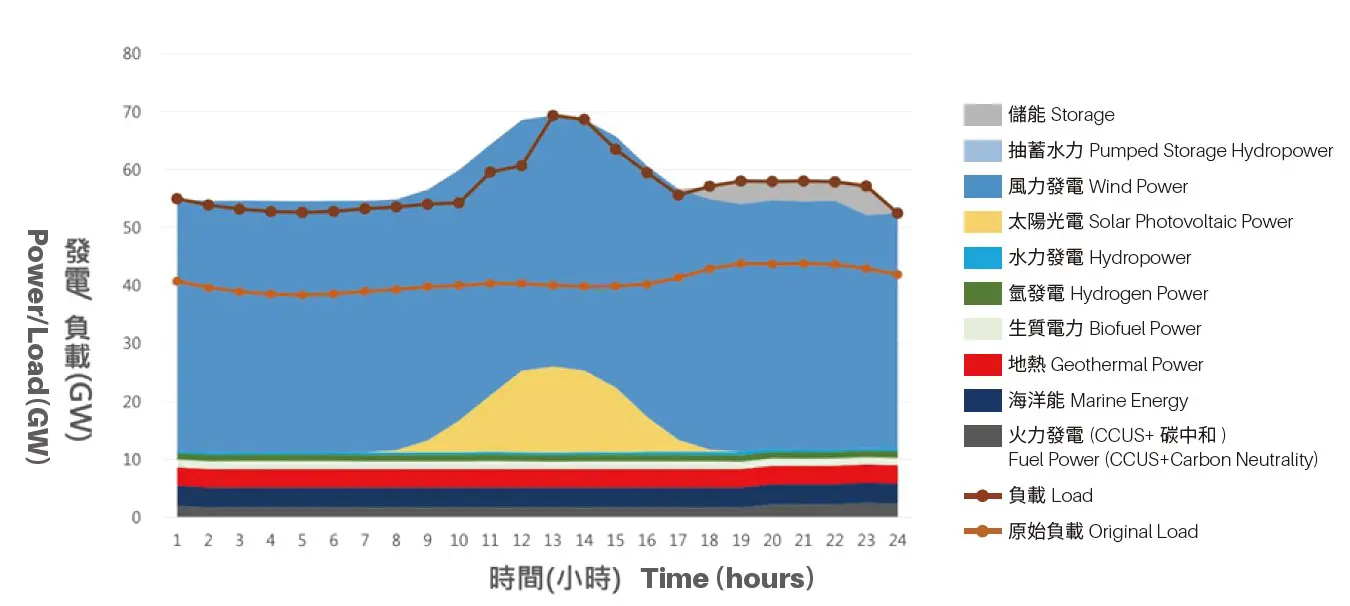〔Tony Yen〕Systems Thinking Regarding Energy Transition Policies: Finding the Tipping Point for Transportation and Grid Transition

〔Tony Yen〕Systems Thinking Regarding Energy Transition Policies: Finding the Tipping Point for Transportation and Grid Transition
In the process of the energy transition, market mechanisms play a definite role in the development of renewable energy and its complementary technologies. Some spontaneous dynamics in the market also boost the promotion of energy transition. For example, the price of electricity in the wholesale market is traditionally determined by the marginal cost of generation on the supply end, but as the share of renewable energy grows and the price curve fluctuates more vigorously, flexible resources such as energy storage, demand response, green hydrogen energy, and smart charging for electric vehicles can be leveraged to reduce the cost of electricity or even profit by peak cutting or reselling at a higher price. This provides incentives for market participants to improve their flexibility. As the wholesale electricity market evolves into a demand-driven market, renewable energy will still retain its profitability, while the overall flexibility of the power system is also enhanced.

Figure 1: A diagram of market clearing in a wholesale electricity market dominated by green energy and flexible resources, when the green power generation is higher (left) and lower (right). In such cases, the wholesale electricity market will close at a price driven by flexible demand or energy storage.
However, given future uncertainties, attempting to achieve all energy transition goals through short-term market-based economic incentives alone would be rather risky. It is for this reason that energy transition cases of most nations were usually initiated with non-market-based supportive policies, and then gradually shifted to market-based mechanisms later on. Starting from fixed Feed-In Tariffs to competitive bidding or Feed-In Tariff premiums based on electricity market prices is a common trend in the evolution of domestic and international support policies for renewable energy in recent years.
In orthodox economic theories, economic policies other than initial property redistribution affect the short-term economic efficiency of society. However, policy researchers on energy transition have mostly approached the issue from the perspective of complex systems science, emphasizing long-term needs for various non-market supportive policies in building large sociotechnical systems that facilitate the energy transition. Two core concepts of complex systems science play an important role in such an analytical perspective. One is the path dependence generated by the inertia of the socio-technical system after a specific transition path has been selected. The other is the tipping point allowing socio-technical systems to break through under specific external conditions, policy promotions, and social atmospheres, the systems are then able to break away from their original inertia, take a new path, and generate new path dependence afterwards.
In the following paragraph, One will apply the journal article written by Simon Sharpe and Timothy M. Lenton in 2021 as an example of how to use tipping points and path dependence to analyze policies that support energy transition. Sharpe and Lenton argue that in countries like Norway, which leads the world in electric vehicle market share, the first tipping point in transportation transition has already been achieved through supportive policies that make electric vehicles a more attractive private vehicle than traditional petrol cars. At the same time, since such countries have clear and strict timelines for prohibiting petrol cars, both the producers and consumers have been given enough signals to understand that the phase-outs of petrol cars are unlikely to be reversed, so the second tipping point (electric vehicles become more attractive than conventional petrol cars without policy support) becomes inevitable. Once the second tipping point has been reached in countries like Norway, the transportation sector's new path dependence may further influence other countries or other societal technology systems. In that case, other countries will have the opportunity to break through the same two tipping points without having to provide the same level of supportive policies; at the same time, EV development will facilitate an easier transition for power sectors by lowering battery costs and increasing production capacity.

Figure2: Two tipping points in the process of replacing fuel vehicles with electric vehicles and the potential spillover effects that follow (Sharpe and Lenton, 2021)
Limiting the grid share of renewable energy is another energy transition policy that can be analyzed in terms of path dependency and tipping points. The path dependence formed under the power system long relying on the electricity generated by the large traditional power plants, currently limits the share of instantaneous power output from various renewable energy sources such as wind and solar. Lifting such a restriction completely or to a large degree would be a tipping point in grid operations since it would mark the technical feasibility of an energy system composed solely of renewable energy. From there on, opportunities will emerge to revise society's imagination about the ultimate share of renewable energy on the net-zero pathway and to reduce the dependence on carbon capture technologies of future energy systems.
In such a context, I believe it is crucial to include "power systems operating at 100% renewable energy" as one of the goals of the 2050 Net-Zero Pathway, which shall also be used as a basis for supportive policies for flexible resources, mostly inverters, to gradually satisfy the various grid services that were once solely relying on conventional power plants. Whenever a grid service gets fully covered by new flexible resources, the economic viability and legitimacy of continuing conventional power plant operations are further weakened. The myth that renewable energy will jeopardize grid stability will gradually be dispelled, and the energy transition will continue on a positive path of dependence.
Demand Simulation of Winter, 2050
Renewable energy generation shall be consistently higher than the load for the entire day; on the other hand, certain fuel power plants must still operate at the lowest level to maintain system stability. Excess power will be transferred using storage systems, with hydrogen production being a more flexible application of storage methods.

Figure3: In the current net-zero carbon emissions pathway simulations provided by the Ministry of Economic Affairs of Taiwan, it is still assumed that the power system will still rely on conventional power plants to ensure grid stability services such as rotational inertia and voltage control (Ministry of Economic Affairs of Taiwan)
Note 1: This diagram shows the predicted conditions during off-peak days in winter. The results will change depending on power shares and load changes.
Note 2: The simulation is presented in hourly blocks for an understanding of overall power supply and demand, and short-term fluctuations have not been taken into consideration.

Tony Yen
Tony is a Ph.D. candidate in the department of industrial economics and technology management, NTNU. His main research focus is the potential roles of end-users and other distributed resources in a smart distribution network under different energy transition pathways. He used to study renewable energy engineering and management in University of Freiburg and analyzed the impacts of renewable energy participation in different energy and flexibility markets.
More related articles
